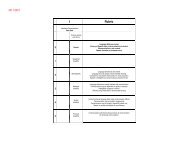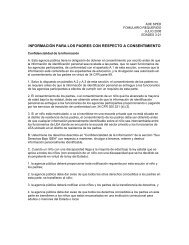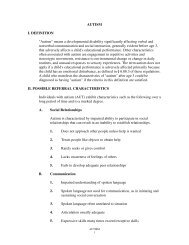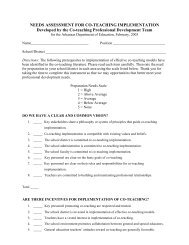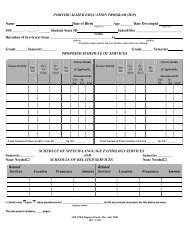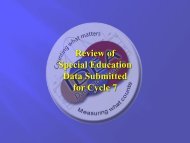Speech or Language Impairment - ADE Special Education
Speech or Language Impairment - ADE Special Education
Speech or Language Impairment - ADE Special Education
You also want an ePaper? Increase the reach of your titles
YUMPU automatically turns print PDFs into web optimized ePapers that Google loves.
SPEECH OR LANGUAGE IMPAIRMENT<br />
I. DEFINITION<br />
"<strong>Speech</strong> <strong>or</strong> <strong>Language</strong> <strong>Impairment</strong>" means a communication dis<strong>or</strong>der, such as<br />
stuttering, impaired articulation, a language impairment, <strong>or</strong> a voice impairment,<br />
that adversely affects a child's educational perf<strong>or</strong>mance.<br />
The operational definition under Arkansas regulations, which is designed to be<br />
compatible with the Federal definition, is as follows: "<strong>Speech</strong> <strong>or</strong> <strong>Language</strong><br />
<strong>Impairment</strong>" means a communication dis<strong>or</strong>der such as deviant articulation,<br />
fluency, voice, and/<strong>or</strong> comprehension and/<strong>or</strong> expression of language, spoken <strong>or</strong><br />
written, which impedes the child's acquisition of basic cognitive and/<strong>or</strong> affective<br />
skills, as reflected in the Arkansas Department of <strong>Education</strong> curriculum standards.<br />
II. POSSIBLE REFERRAL CHARACTERISTICS<br />
A. Intellectual<br />
1. Intellectual functioning is not as strong an indicat<strong>or</strong> as are<br />
other referral characteristics<br />
B. Academic<br />
1. Overall achievement may be below expectancy in relation<br />
to chronological age, mental age, <strong>or</strong> both<br />
2. Achievement in reading, spelling, written composition,<br />
grammatical usage <strong>or</strong> math processes may be below<br />
expected levels, often with delay <strong>or</strong> difficulty in acquisition<br />
of pre-reading <strong>or</strong> other readiness skills<br />
3. W<strong>or</strong>d knowledge may be below expectancy<br />
4. W<strong>or</strong>d substitutions may occur frequently in reading and in<br />
writing from copy <strong>or</strong> reproducing from recall<br />
C. Behavi<strong>or</strong>al<br />
1. Hesitates <strong>or</strong> refuses to participate in verbal activities<br />
2. Is inattentive, distractible; exhibits po<strong>or</strong> concentration; has<br />
difficulty "tuning in" to tasks <strong>or</strong> switching tasks<br />
3. Displays refusal behavi<strong>or</strong> and/<strong>or</strong> low frustration tolerance<br />
4. Perseverates verbally and/<strong>or</strong> mot<strong>or</strong>ically<br />
SPEECH OR LANGUAGE IMPAIRMENT<br />
1
5. Has difficulty following directions; must be "shown" what<br />
to do<br />
6. Has trouble analyzing/integrating inf<strong>or</strong>mation from what is<br />
seen, heard <strong>or</strong> felt<br />
7. Is embarrassed <strong>or</strong> disturbed by his speech, regardless of age<br />
8. Has difficulty interpreting emotions, attitudes and<br />
intentions others communicate through nonverbal aspects<br />
of communication (facial expressions and body language)<br />
9. Responds inappropriately to subtle nonverbal social cues,<br />
often giving inappropriate social responses<br />
10. May not establish <strong>or</strong> maintain eye contact<br />
11. Repeats what is said to him <strong>or</strong> what he is reading, vocally<br />
<strong>or</strong> subvocally<br />
12. Uses gestures extensively while talking <strong>or</strong> in place of<br />
speech<br />
13. Is slow to respond during verbal interaction <strong>or</strong> following<br />
verbal cues<br />
14. Is compulsive in actions <strong>or</strong> speech<br />
15. Acts impulsively, without f<strong>or</strong>ethought; often responds<br />
bef<strong>or</strong>e instructions are completed<br />
16. Is echolalic<br />
17. Has difficulty remembering and finding specific w<strong>or</strong>ds to<br />
use during conversation <strong>or</strong> when answering a question<br />
D. Communicative Abilities<br />
(Refer to other sections within Possible Referral Characteristics f<strong>or</strong><br />
additional traits)<br />
1. Asks questions and/<strong>or</strong> responds to questions<br />
inappropriately (especially "why" and "how" question<br />
f<strong>or</strong>ms)<br />
2. Has difficulty discriminating likenesses and differences<br />
SPEECH OR LANGUAGE IMPAIRMENT<br />
2
3. Has difficulty analyzing and synthesizing sound sequences,<br />
f<strong>or</strong>ming stable phoneme/grapheme associations, and<br />
segmenting w<strong>or</strong>ds into smaller grammatical units<br />
4. Has difficulty learning and applying concepts of time,<br />
space, quantity, size, prop<strong>or</strong>tion and measurement<br />
5. Has difficulty comprehending and using linguistically<br />
complex sentences<br />
6. Has problems acquiring and using grammatical rules and<br />
patterns f<strong>or</strong> w<strong>or</strong>d and sentence f<strong>or</strong>mation<br />
7. Cannot identify pronouns and their antecedents<br />
8. Cannot relate the events in a st<strong>or</strong>y <strong>or</strong> inf<strong>or</strong>mation in a<br />
rep<strong>or</strong>t in sequential <strong>or</strong>der<br />
9. Cannot predict outcomes, make judgments, draw<br />
conclusions <strong>or</strong> generate alternatives after appropriate<br />
discussion<br />
10. Does not recognize and understand figurative language<br />
such as alliteration, similes, metaph<strong>or</strong>s, personification, and<br />
idioms<br />
11. Does not recognize syllabication and accent in w<strong>or</strong>ds<br />
12. Cannot give clear and appropriate directions<br />
13. Has difficulty interpreting <strong>or</strong> f<strong>or</strong>mulating (<strong>or</strong>al <strong>or</strong> written)<br />
compound <strong>or</strong> complex sentences, and/<strong>or</strong> sentences which<br />
compare and contrast ideas <strong>or</strong> show cause-effect<br />
relationships<br />
14. Cannot summarize essential details from hearing <strong>or</strong> reading<br />
a passage, n<strong>or</strong> distinguish relevant from irrelevant<br />
inf<strong>or</strong>mation<br />
15. Has difficulty analyzing and solving math reading<br />
problems of various complexity (one <strong>or</strong> multiple step),<br />
including those involving probability<br />
16. Will not initiate conversations<br />
SPEECH OR LANGUAGE IMPAIRMENT<br />
3
17. Cannot identify <strong>or</strong> use exposit<strong>or</strong>y, descriptive <strong>or</strong> narrative<br />
language in written w<strong>or</strong>k<br />
18. Cannot write an <strong>or</strong>ganized paragraph using related<br />
sentences of varying length and grammatical complexity<br />
19. Has problems interpreting and/<strong>or</strong> using vocal pitch,<br />
intensity, and timing f<strong>or</strong> purposes of communicating subtle<br />
distinctions in emotion and intention<br />
20. Has inappropriate vocal pitch f<strong>or</strong> age and sex<br />
21. Does not use appropriate vocal control, particularly in<br />
regulating speaking volume (unusually loud <strong>or</strong> soft)<br />
22. Has breathy, harsh, husky <strong>or</strong> monotone voice<br />
23. Continually sounds congested (denasal)<br />
24. Sounds unusually nasal; voice has a "whining" quality<br />
25. Has abn<strong>or</strong>mal rhythm <strong>or</strong> rate of speech<br />
26. Frequently prolongs <strong>or</strong> repeats sounds, w<strong>or</strong>ds, phrases<br />
and/<strong>or</strong> sentences during speech<br />
27. Has unintelligible (cannot be understood) <strong>or</strong> indistinct<br />
speech<br />
28. Has difficulty articulating sounds within w<strong>or</strong>ds<br />
E. Physical<br />
1. Conditions are indicated in the student's<br />
medical/developmental hist<strong>or</strong>y, such as cleft lip and/<strong>or</strong><br />
palate, deviant palatal-pharyngeal structure, cerebral palsy,<br />
muscular dystrophy, brain injury, aphasia, vocal nodules <strong>or</strong><br />
other pathology of the vocal mechanism, hearing loss,<br />
myringotomy <strong>or</strong> other aural surgery, <strong>or</strong>ofacial<br />
abn<strong>or</strong>malities, congenital dis<strong>or</strong>ders<br />
2. Has continuous allergy problems <strong>or</strong> frequent colds<br />
3. Has deviant dental structure<br />
4. Has <strong>or</strong>al muscular co<strong>or</strong>dination slower than n<strong>or</strong>mal<br />
SPEECH OR LANGUAGE IMPAIRMENT<br />
4
III. SCREENING INFORMATION<br />
5. Displays clumsiness <strong>or</strong> general mot<strong>or</strong> inco<strong>or</strong>dination<br />
A. Required<br />
1. Hearing<br />
2. Vision<br />
B. Recommended<br />
1. F<strong>or</strong>mal<br />
a. Inf<strong>or</strong>mation derived from school-wide, grade and/<strong>or</strong><br />
class testing<br />
2. Inf<strong>or</strong>mal<br />
a. Checklists<br />
b. Invent<strong>or</strong>ies<br />
c. Interviews<br />
IV. REQUIRED EVALUATION DATA<br />
A. Social Hist<strong>or</strong>y<br />
d. Observation(s) in classes and/<strong>or</strong> other settings<br />
e. Access to and review of existing rec<strong>or</strong>ds and<br />
available inf<strong>or</strong>mation<br />
B. Individual Achievement (f<strong>or</strong>mal <strong>or</strong> inf<strong>or</strong>mal)<br />
C. Communicative Abilities (Required as described below)<br />
The speech-language pathologist (SLP) is to conduct a th<strong>or</strong>ough<br />
and balanced speech, language, <strong>or</strong> communication assessment.<br />
The foundation of a quality individualized assessment is to<br />
establish a complete student hist<strong>or</strong>y. That inf<strong>or</strong>mation should guide<br />
the selection of subsequent assessment tools and activities, which<br />
should reflect multiple perspectives. No single assessment measure<br />
can provide sufficient data to create an accurate and<br />
comprehensive communication profile.<br />
SPEECH OR LANGUAGE IMPAIRMENT<br />
5
1. F<strong>or</strong> Verbal Communicat<strong>or</strong>s (Students using spoken<br />
language to communicate)<br />
Two <strong>or</strong> m<strong>or</strong>e tests and/<strong>or</strong> procedures which delineate the<br />
specific nature and extent of the dis<strong>or</strong>der.<br />
2. F<strong>or</strong> Nonverbal Communicat<strong>or</strong>s (Students who are<br />
nonspeaking <strong>or</strong> exhibit severe difficulties using verbal<br />
communication to make themselves understood by others)<br />
An assessment f<strong>or</strong> augmentative/alternative communication<br />
(AAC) perf<strong>or</strong>med by a multidisciplinary team with<br />
experience, training, and competence in AAC. (Refer to<br />
Assistive Technology Section 5.08)<br />
3. Oral-peripheral speech mechanism examination, which<br />
includes a description of the status and function of <strong>or</strong>ofacial<br />
structures. This examination must be conducted in addition<br />
to the requirement f<strong>or</strong> either verbal communicat<strong>or</strong>s (1) <strong>or</strong><br />
nonverbal communicat<strong>or</strong>s (2). If, after examination,<br />
feeding, and/<strong>or</strong> swallowing are a concern, the SLP should<br />
make appropriate referral f<strong>or</strong> further medical evaluation.<br />
4. Other<br />
a. Combining standardized (n<strong>or</strong>m-referenced) with<br />
nonstandardized (descriptive) assessment using<br />
multiple methods will assure the collection of<br />
student-centered, contextualized, perf<strong>or</strong>mancebased,<br />
and functional inf<strong>or</strong>mation about the child's<br />
communicative abilities and needs. Standardized<br />
assessment may consist of any diagnostic tool that<br />
compares results to an appropriate n<strong>or</strong>mative<br />
sample. Nonstandardized assessment may consist of<br />
criterion-referenced assessment, curriculum-based<br />
assessment, dynamic assessment, language samples,<br />
and structured probes.<br />
b. When the SLP deems additional medical <strong>or</strong> other<br />
professional inf<strong>or</strong>mation is necessary, appropriate<br />
referral should be made with resulting inf<strong>or</strong>mation<br />
considered in the process of f<strong>or</strong>mulating diagnostic<br />
and/<strong>or</strong> programmatic impressions.<br />
SPEECH OR LANGUAGE IMPAIRMENT<br />
6
V. OPTIONAL EVALUATION DATA<br />
A. Individual intelligence<br />
B. P<strong>or</strong>tfolios<br />
C. Anecdotal rec<strong>or</strong>ds<br />
c. Related functions which may contribute to <strong>or</strong><br />
underlie a communication dis<strong>or</strong>der must also be<br />
considered. F<strong>or</strong> example, impaired articulation may<br />
be related to an audit<strong>or</strong>y acuity and/<strong>or</strong> perceptual<br />
deficit, a mot<strong>or</strong>-speech problem, overall<br />
maturational lag, <strong>or</strong> deviant <strong>or</strong>al structure. Such<br />
determinations cannot be made solely through<br />
administration of a standard test of articulat<strong>or</strong>y<br />
ability.<br />
d. When evaluating speech and/<strong>or</strong> language f<strong>or</strong><br />
disability categ<strong>or</strong>y other than SI, refer to required<br />
evaluation components f<strong>or</strong> the disability categ<strong>or</strong>y<br />
being considered (e.g., hearing impairment, mental<br />
retardation).<br />
D. Checklists and developmental scales<br />
VI. EVALUATION DATA ANALYSIS<br />
A. Types of Communication Dis<strong>or</strong>ders<br />
1. <strong>Language</strong> Dis<strong>or</strong>der - Impaired comprehension and/<strong>or</strong> use of<br />
spoken, written, and/<strong>or</strong> other symbol systems. This dis<strong>or</strong>der<br />
may involve the f<strong>or</strong>m of language (phonology,<br />
m<strong>or</strong>phology, syntax), the content and meaning of language<br />
(semantics, prosody), and/<strong>or</strong> the function of language<br />
(pragmatics) in communication. Such dis<strong>or</strong>ders may<br />
involve one, all, <strong>or</strong> a combination of the following<br />
components of language.<br />
F<strong>or</strong>m of <strong>Language</strong><br />
a. Phonology - is the sound system of language and<br />
the rules that govern the sound combinations.<br />
SPEECH OR LANGUAGE IMPAIRMENT<br />
7
. M<strong>or</strong>phology - Is the system that governs the<br />
structure of w<strong>or</strong>ds and the construction of w<strong>or</strong>d<br />
f<strong>or</strong>ms.<br />
c. Syntax - Is the system governing the <strong>or</strong>der and<br />
combination of w<strong>or</strong>ds to f<strong>or</strong>m sentences, and the<br />
relationships among the elements within a sentence.<br />
Content and Meaning of <strong>Language</strong><br />
d. Semantics - is the system that governs the meanings<br />
of w<strong>or</strong>ds in sentences.<br />
e. Prosody - Is the feature of communication involving<br />
stress and intonation patterns that convey the<br />
meaning of spoken utterances, determined primarily<br />
by variations in pitch, loudness and duration. Status<br />
may be rep<strong>or</strong>ted from inf<strong>or</strong>mal observation.<br />
Function of <strong>Language</strong><br />
f. Pragmatics - is the system that combines the above<br />
language components in functional and socially<br />
appropriate communication.<br />
Perception and Processing of <strong>Language</strong><br />
g. Perception and processing - is the manner by which<br />
language is internally received and responded to<br />
and involves attention, sequencing, mem<strong>or</strong>y,<br />
analysis, synthesis and/<strong>or</strong> discrimination abilities.<br />
2. <strong>Speech</strong> Production Dis<strong>or</strong>der - <strong>Impairment</strong> of the<br />
articulation of speech sounds, fluency and/<strong>or</strong> voice. Such<br />
dis<strong>or</strong>ders may involve one, all <strong>or</strong> a combination of the<br />
following components of the speech production system.<br />
a. Articulation - an articulation dis<strong>or</strong>der is the<br />
production and combination of speech sounds. An<br />
articulation dis<strong>or</strong>der may manifest as an individual<br />
sound deficiency (traditional articulation dis<strong>or</strong>der),<br />
incomplete <strong>or</strong> deviant use of the phonological<br />
system (phonological dis<strong>or</strong>der), <strong>or</strong> po<strong>or</strong><br />
co<strong>or</strong>dination of <strong>or</strong>al-mot<strong>or</strong> mechanism f<strong>or</strong> purposes<br />
of speech production (apraxia/dysarthria).<br />
SPEECH OR LANGUAGE IMPAIRMENT<br />
8
. Voice - is the feature of speech production<br />
that impacts tonal quality, pitch, loudness and<br />
resonance of speech. Adequate status may be<br />
rep<strong>or</strong>ted from inf<strong>or</strong>mal observation.<br />
c. Fluency - is the feature of speech production that<br />
impacts the rate and rhythm of conversational<br />
speech. Slight to severe physical behavi<strong>or</strong>s may also<br />
accompany the dis<strong>or</strong>der. Adequate status may be<br />
rep<strong>or</strong>ted from inf<strong>or</strong>mal observation.<br />
In analyzing communicative abilities, the<br />
SLP should be aware of fact<strong>or</strong>s which represent<br />
communication differences rather than dis<strong>or</strong>ders.<br />
Communication differences refer to maturational,<br />
regional, social <strong>or</strong> cultural/ethnic speech and/<strong>or</strong><br />
language variations that are not considered<br />
communication dis<strong>or</strong>ders.<br />
After carefully analyzing the evaluation data<br />
pertaining to the student's communicative abilities,<br />
the speech-language pathologist will complete a<br />
written evaluation rep<strong>or</strong>t which includes<br />
impressions indicating the presence <strong>or</strong> absence of a<br />
clinical dis<strong>or</strong>der.<br />
Through committee interaction this evaluation<br />
inf<strong>or</strong>mation will be integrated with all other data<br />
(e.g., teacher observations, including those of<br />
educational perf<strong>or</strong>mance, and other f<strong>or</strong>mal and<br />
inf<strong>or</strong>mal assessment data) gathered throughout the<br />
screening/ evaluation processes. This will be done<br />
so that the committee may determine if a disabling<br />
condition exists which impedes the student's<br />
acquisition of expected academic, behavi<strong>or</strong>al,<br />
social, vocational, and functional perf<strong>or</strong>mance<br />
goals.<br />
The committee must judge what the consequences<br />
of the impairment are f<strong>or</strong> the student in relation to<br />
expected learnings within the curriculum, as<br />
established at each grade and/<strong>or</strong> chronological age<br />
level of skill development. The relationship of the<br />
communication dis<strong>or</strong>der to expected learnings<br />
should be rec<strong>or</strong>ded on the Evaluation/Programming<br />
Conference Decision f<strong>or</strong>m. Once the adverse affect<br />
SPEECH OR LANGUAGE IMPAIRMENT<br />
9
VII. PROGRAMMING CONSIDERATIONS<br />
on educational perf<strong>or</strong>mance is established, a<br />
determination must be made of the c<strong>or</strong>responding<br />
need f<strong>or</strong> special education services.<br />
When a student whose eligibility is based on a<br />
disability categ<strong>or</strong>y other than "<strong>Speech</strong> <strong>or</strong> <strong>Language</strong><br />
<strong>Impairment</strong>" exhibits a concomitant communication<br />
dis<strong>or</strong>der, (as determined through f<strong>or</strong>mal evaluation),<br />
then circumstances exist f<strong>or</strong> the provision of speech<br />
and/<strong>or</strong> language services.<br />
Service delivery is a dynamic concept and changes as the needs of the students<br />
change; theref<strong>or</strong>e, in designing a program to address the communication needs of<br />
students with disabilities, a variety of service delivery options should be<br />
considered. No one service delivery model listed should be used exclusively<br />
within a district's speech and language program. Service delivery options include<br />
direct and indirect services. Direct services may consist of therapy integrated into<br />
the classroom, pull-out therapy in an individual <strong>or</strong> group setting, community<br />
based instruction, and/<strong>or</strong> a combination. Indirect services may include<br />
collab<strong>or</strong>ation <strong>or</strong> consultation with parents, general and special education teachers<br />
and other service delivery providers.<br />
Decisions as to how instruction should be provided (e.g., in the context of a direct<br />
speech-language therapy program, a special education classroom and/<strong>or</strong> a general<br />
education classroom), must be based on the individual needs of the child. Services<br />
must be provided in the least restrictive environment.<br />
Pri<strong>or</strong> to recommending dismissal from speech <strong>or</strong> language therapy services,<br />
existing data must be reviewed and may include a comprehensive evaluation, if<br />
deemed appropriate <strong>or</strong> required. Refer to <strong>Special</strong> <strong>Education</strong> Eligibility Criteria<br />
and Program Guidelines f<strong>or</strong> Children with Disabilities, Ages 3-21, Part III,<br />
Section 1, f<strong>or</strong> a complete review of dismissal criteria.<br />
SPEECH OR LANGUAGE IMPAIRMENT<br />
10




